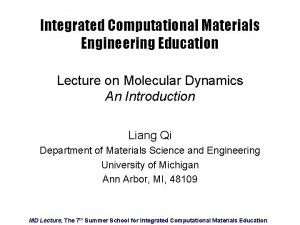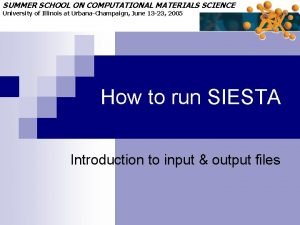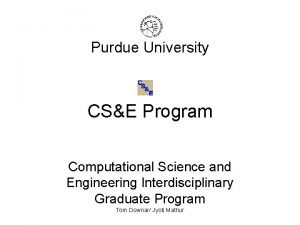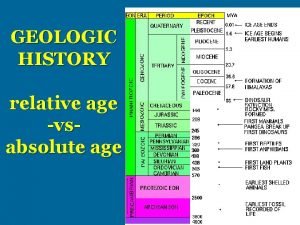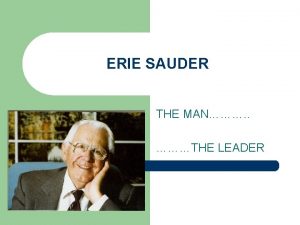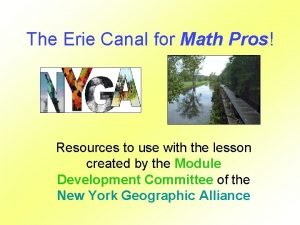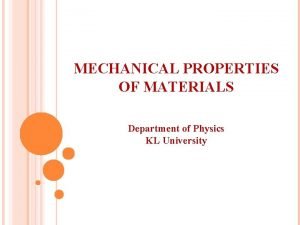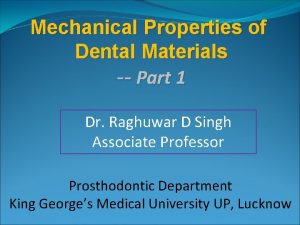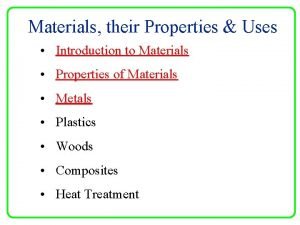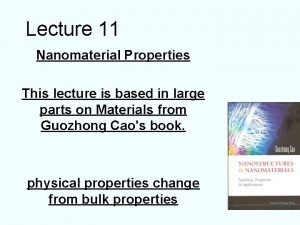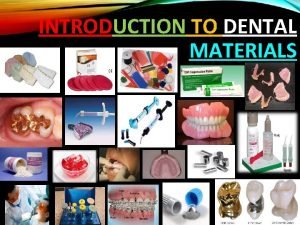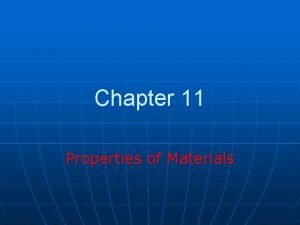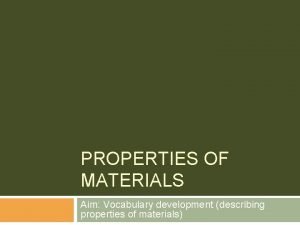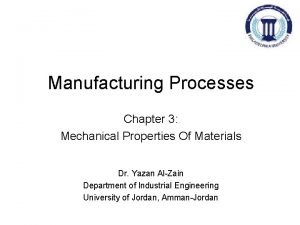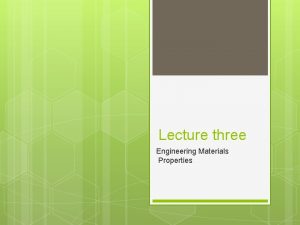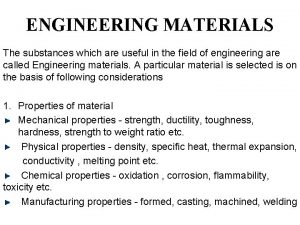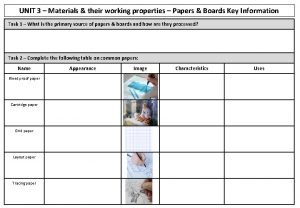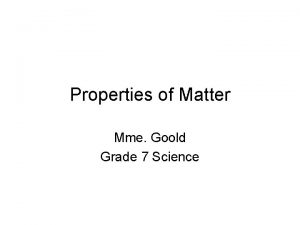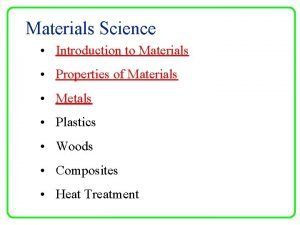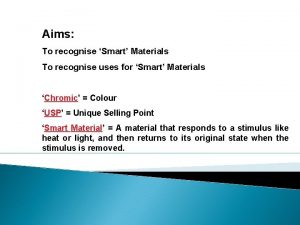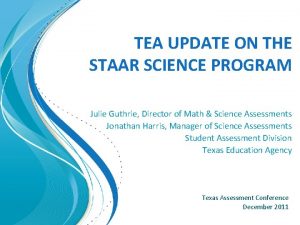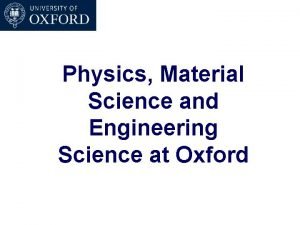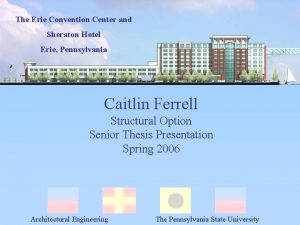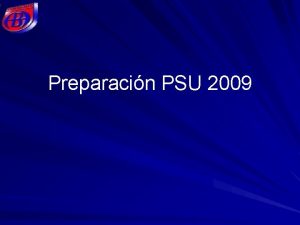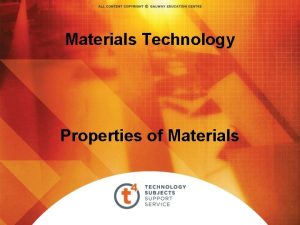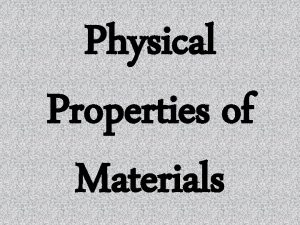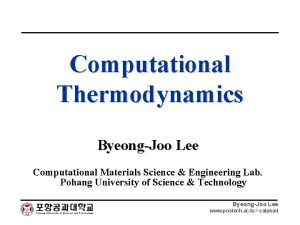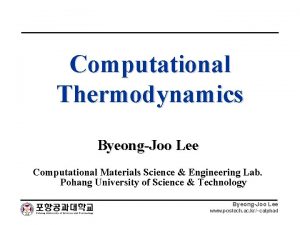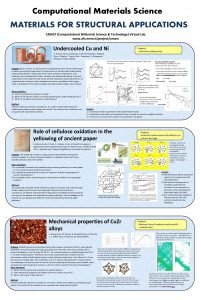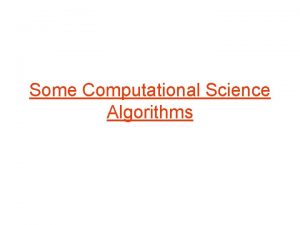PSU Erie Computational Materials Science Properties of Point

















![PSU – Erie Computational Materials Science 2001 Convergence: Basis size DE [e. V] • PSU – Erie Computational Materials Science 2001 Convergence: Basis size DE [e. V] •](https://slidetodoc.com/presentation_image/ab9be3cc92710ef741ce31ee55fb5d8a/image-18.jpg)





















![PSU – Erie Computational Materials Science 2001 • [D] concentration thermally activated with Ed PSU – Erie Computational Materials Science 2001 • [D] concentration thermally activated with Ed](https://slidetodoc.com/presentation_image/ab9be3cc92710ef741ce31ee55fb5d8a/image-40.jpg)












- Slides: 52

PSU – Erie Computational Materials Science Properties of Point Defects in Semiconductors Dr. Blair R. Tuttle Assistant Professor of Physics Penn State University at Erie, The Behrend College © Blair Tuttle 2001

PSU – Erie Computational Materials Science 2001 Outline • Semiconductor review and motivation • Point defect calculations using ab initio DFT • Applications from recent research: – Donor and acceptor levels for atomic H in c-Si – Paramagnetic defects – Energies of H in Si environments – Hydrogen in amorphous silicon – Hydrogen at Si-Si. O 2 interface © Blair Tuttle 2001 2

PSU – Erie Computational Materials Science 2001 Properties of solids Semiconductors Conductors E E Insulators E Band Gap< 2 e. V Band Gap > 2 e. V occupied N • Wires © Blair Tuttle 2001 N • Switches N • Barriers 3

PSU – Erie Computational Materials Science 2001 Silicon as prototype semiconductor Tetrahedral Coordination 4 bonds per Si Diamond Structure: N Semiconductor: Eg = 1. 1 e. V : © Blair Tuttle 2001 E-Fermi E 4

PSU – Erie Computational Materials Science P-type Boron acceptors -1 Doping in c-Si h+ 2001 N-type Phosphorous donors +1 e- N © Blair Tuttle 2001 E E 5

PSU – Erie Computational Materials Science 2001 Metal Oxide Semiconductor Field Effect Transistor (MOSFET) Source © Blair Tuttle 2001 Gate Drain Lds ~ 90 nm tox ~ 2. 0 nm Vsd ~ 2. 0 V 6

PSU – Erie Computational Materials Science 2001 Hydrogen in Silicon Systems • • Compensates both p-type and n-type doping Passivates dangling bonds at surfaces and interfaces Hydrogen related charge traps in MOSFETs Participates in metastable defect formation in polyand amorphous silicon • Forms very mobile H 2 molecules in bulk Si • Forms large platelets used for cleaving silicon For more details see reference below and references therein: C. Van de Walle and B. Tuttle, “Theory of hydrogen in silicon devices” IEEE Transactions on Electron Devices, vol. 47 pg. 1779 (2000) © Blair Tuttle 2001 7

PSU – Erie Computational Materials Science 2001 Concentration of defects: H in Si • Etot = total energy for bulk cell with Nsi silicon atoms and NH hydrogen atoms. • m. H , m. Si = the chemical potential for hydrogen, Si • The charge q and the Fermi energy (EF). © Blair Tuttle 2001 8

PSU – Erie Computational Materials Science 2001 Acceptor and Donor levels for atomic hydrogen in crystalline silicon • Donor level is the Fermi Energy when: • Calculate Eform for H at its local minima for each charge state q = +1, 0, -1 • Calculate valence band maximum to compare charge states © Blair Tuttle 2001 9

PSU – Erie Computational Materials Science 2001 Choose Method • Semi-empirical – Tight binding (TB) – Classical Potentials • Ab intio – Quantum Monte Carlo (QMC) – Hartree-Fock methods (HF) – Density Function Theory (DFT) For more details on a state-of-the-art implimentation of DFT: Kresse and Furthmuller, ”Efficient iterative schemes for ab intio total-energy calculations using a plane wave basis set” Phys. Rev. B vol. 54 pg. 11169 (1996). http: //cms. mpi. univie. ac. at/vasp/vasp. html © Blair Tuttle 2001 10

PSU – Erie Computational Materials Science 2001 Review of DFT • Solve the Kohn-Sham equations: For more details see review articles below: W. E. Pickett, “Pseudopotential methods in condensed matter applications” Computer Physics Reports, vol. 9 pg. 115 (1989). M. C. Payne et al. “Iterative minimization techniques for ab initio total-energy calculations” © Blair Tuttle 2001 Review of Modern Physics vol. 64 pg. 1045 (1992). 11

PSU – Erie Computational Materials Science 2001 Choose {ex, cor} functional • Local density approximation (LDA) – Calculates exhange-correlation energy (Eex, cor) based only on the local charge density – Rigorous for slowly varying charge density • General gradient approximations (GGA) – Calculates Eex, cor using density and gradients – Improves many shortcoming of LDA For more details see reference below: Kurth, Perdew, and Blaha “Molecular and solid-state tests of density functional approximations: LSD, GGAs, and meta-GGAs” Int. J. of Quantum Chem. Vol. 75 pg. 889 ( 1999). © Blair Tuttle 2001 12

PSU – Erie Computational Materials Science 2001 Results of DFT-LDA • • Bond lengths, lattice constants ~ 1 – 5 % (low) Binding and cohesive energies ~ 10 % (high) Vibrational frequencies ~ 5 – 10 % (low) Valence bands good – valence band offsets for semiconductors • Wavefunctions good – Hyperfine parameters © Blair Tuttle 2001 13

PSU – Erie Computational Materials Science 2001 Shortcomings of DFT-LDA • Poor when charge gradients vary significantly (better in GGA) – Atomic energies too low: EH = -13. 0 e. V – Barriers to molecular dissociation often low, Example: H + H 2 = H 3 – Energy of Phases, Ex: Stishovite vs Quartz • Semiconductor band gaps poor ~ 50 % low © Blair Tuttle 2001 14

PSU – Erie Computational Materials Science 2001 Choose boundary conditions • Cluster models (20 – 1000 atoms) – Defect-surface interactions – Passivate cluster surface with hydrogen – Wavefunctions localized • Periodic supercell (20 – 1000 atoms) – Defect-defect interactions – Wavefunctions de-localized – Bands well defined © Blair Tuttle 2001 15

PSU – Erie Computational Materials Science 2001 Choose basis for wavefunctions • Localized pseudo-atomic orbitals – Efficient but not easy to use or improve results • Plane Waves – Easy to use and improve results: © Blair Tuttle 2001 16

PSU – Erie Computational Materials Science 2001 Testing Convergence • Convergence calculation – Total energy for defect at minima – Relative energies for defect in various positions • Accuracy vs. Computational Cost • Variables to converge – Basis set size – Supercell size – Reciprocal space integration – Spin polarization (include or not) © Blair Tuttle 2001 17
![PSU Erie Computational Materials Science 2001 Convergence Basis size DE e V PSU – Erie Computational Materials Science 2001 Convergence: Basis size DE [e. V] •](https://slidetodoc.com/presentation_image/ab9be3cc92710ef741ce31ee55fb5d8a/image-18.jpg)
PSU – Erie Computational Materials Science 2001 Convergence: Basis size DE [e. V] • Plane waves are a complete basis so crank up the G vectors until convergence is reached. © Blair Tuttle 2001 EPW [Ryd. ] 18

PSU – Erie Computational Materials Science 2001 Convergence: Supercell size • Prevent defect-defect interactions. – Electronic localization of defect level as determined by k-point integration – Steric relaxations: di-vancancy in silicon – Coulombic interaction of charged defects For more details see reference below and references therein: 1. C. Van de Walle and B. Tuttle, “Theory of hydrogen in silicon devices” IEEE Transactions on Electron Devices, vol. 47 pg. 1779 (2000) 2. http: //cms. mpi. univie. ac. at/vasp/vasp. html © Blair Tuttle 2001 19

PSU – Erie Computational Materials Science 2001 Convergence: k-point sampling • Reciprocal space integration – For each supercell size, converge the number of “special” k-points – Data for 8 atom supercell: K points E per Si (e. V) for c-Si DE (e. V) for H+BC in c-Si 2 x 2 x 2 5. 8826 7. 581 3 x 3 x 3 5. 9549 7. 514 4 x 4 x 4 5. 9691 7. 485 5 x 5 x 5 5. 9705 7. 484 © Blair Tuttle 2001 20

PSU – Erie Computational Materials Science 2001 Convergence data at Epw = 15 Ryd. N atoms K points 8 5 x 5 x 5 E per Si (e. V) DE (e. V) for in c-Si H+BC in c-Si 5. 9705 7. 484 64 2 x 2 x 2 5. 9693 7. 311 64 3 x 3 x 3 5. 9700 7. 309 64 4 x 4 x 4 5. 9711 7. 308 216 2 x 2 x 2 5. 9708 7. 240 • N=64, Kpt=2 x 2 x 2 results converged to within 0. 1 e. V © Blair Tuttle 2001 21

PSU – Erie Computational Materials Science 2001 Bandstructure of 64 atom supercell Bulk c-Si + H+BC G L X L G • Bulk bands retained even with defect in calculation © Blair Tuttle 2001 X 22

PSU – Erie Computational Materials Science 2001 Results for H in c-Si EForm Eglda H+1 H 0 H-1 0. 5 e. V 1. 0 e. V EFermi • H 0 and H+1 at global minimum • H-1 at stationary point or saddle point – Will lower its energy by moving to Td site For more info see: C. G. Van de Walle, “Hydrogen in crystalline semiconductors” Deep Centers I Semiconductors , Ed. by S. T. Pantelides, pg. 899 (1992). © Blair Tuttle 2001 23

PSU – Erie Computational Materials Science 2001 Hydrogen in Silicon Solid = LDA, Dashed =LDA + rigid scissor shift E in e. V Exp. LDA © Blair Tuttle 2001 E(0, -) 0. 51 0. 46 E(+, 0) 0. 92 1. 07 E(+, -) 0. 72 0. 77 U-corr -0. 41 -0. 61 24

PSU – Erie Computational Materials Science 2001 H 0 defect level chemistry Si 3 sp 3 001 110 H 1 s • Defect level derived from Si-Si anti-bonding states For more info see: C. G. Van de Walle, “Hydrogen in crystalline semiconductors” Deep Centers I Semiconductors , Ed. by S. T. Pantelides, pg. 899 (1992). © Blair Tuttle 2001 25

PSU – Erie Computational Materials Science 2001 Metal Oxide Semiconductor Field Effect Transistor (MOSFET) Source © Blair Tuttle 2001 Gate Drain Lds ~ 90 nm tox ~ 2. 0 nm Vsd ~ 2. 0 V 26

PSU – Erie 0 H Computational Materials Science 2001 in silicon = paramagnetic defect Si 3 sp 3 001 110 H 1 s For more info see: C. G. Van de Walle and P. Blochl, “First principles calculations of hyperfine parameters” Phys. Rev. B vol. 47 pg. 4244 (1993). © Blair Tuttle 2001 27

PSU – Erie Computational Materials Science 2001 Paramagnetic Defects 1. 2. 3. 4. 5. Atomic Ho in c-Si D center defects in a-Si Pb centers at Si-Si. O 2 interfaces E’ centers in Si. O 2 Atomic Ho in Si. O 2 © Blair Tuttle 2001 28

PSU – Erie Computational Materials Science 2001 Hyperfine parameters • All electron wavefunctions are needed !!!! For more info see: C. G. Van de Walle and P. Blochl, “First principles calculations of hyperfine parameters” Phys. Rev. B vol. 47 pg. 4244 (1993). © Blair Tuttle 2001 29

PSU – Erie Computational Materials Science 2001 Hyperfine parameters for Sidb Isotropic Parameters For more details see: B. Tuttle, “Hydrogen and Pb defects at the Si(111)-Si. O 2 interface” Phys. Rev. B vol. 60 pg. 2631 (1999). © Blair Tuttle 2001 30

PSU – Erie Computational Materials Science 2001 H passivation of defects • Binding energy for hydrogen passivation – Related to the desorption energy – Compare to vacuum annealing experiments © Blair Tuttle 2001 31

PSU – Erie Computational Materials Science 2001 Atomic hydrogen in Silicon 001 Si 3 sp 3 H 1 s • • 110 E ~ 0. 5 --1. 1 e. V H 0 min. energy at BC site, B In disordered Si, strain lowers EB ~ 0. 25 e. V per 0. 1 Ang H+ (BC) and H-(T): Negative U impurity Neutral hydrogen in Si is a paramagnetic defect © Blair Tuttle 2001 32

PSU – Erie Computational Materials Science 2001 H 2 complexes in Silicon • H 2 min. at T site • EB ~ 1. 9 e. V per H atom • 0. 6 e. V less than free space © Blair Tuttle 2001 • H 2* along <111> direction • EB ~ 1. 6 e. V per H atom _ • H+ (BC) + H (T) 33

PSU – Erie Computational Materials Science 2001 H passivation of strained bonds Si 3 sp 3 2 H 1 s 2 (Si-H) • Hydrogen atoms remove electronic band tail states in a-Si • EB ~ 2. 3 e. V per H atom (roughly the same as H 2 in free space) • Negative U complex (equilibrium state includes only 0 or 2 H) © Blair Tuttle 2001 34

PSU – Erie Computational Materials Science 2001 Passivation of a 5 -fold Si defect Si-H Bond Frustrated Bond • 5 -fold Si defects are paramagnetic: • D center in a-Si & Pb center at Si-Si. O 2 interface • EB ~ 2. 45 e. V per H for Si-H at Si-interstitials in c-Si • EB ~ 2. 55 e. V per H for Si-H at a 5 -fold defect in a-Si © Blair Tuttle 2001 35

PSU – Erie Computational Materials Science 2001 H passivation of dangling bonds Si 3 sp 3 H 1 s • Si dangling bonds paramagnetic • EB ~ 4. 1 e. V for H-Si. H 3 • EB ~ 3. 6 e. V for pre-existing isolated Sidb in c-Si • Tuttle EB 2001 ~ 3. 1 - 3. 6 e. V for pre-existing isolated Sidb in a-Si © Blair 36

PSU – Erie Computational Materials Science 2001 Hydrogen in Si. O 2 • H 0 favors open void • EB ~ 0. 1 e. V • Very little experimental info on charge states • Defect is paramagnetic © Blair Tuttle 2001 • H 2 free to rotate • EB ~ 2. 3 e. V per H atom 37

PSU – Erie Computational Materials Science 2001 Binding Energy per H (e. V) 0. 0 H 0 (free) & Si. O 2 1. 0 2. 0 3. 0 H at pre-existing isolated silicon dangling bond (db) H in c-Si H 2* in c-Si H 2 (free) & Si. O 2 (Si-H H-Si) in a-Si © Blair Tuttle 2001 4. 0 H at pre-existing db with Si-H in a cluster e. g. a Si vacancy H at pre-existing “frustrated” Si bond 38

PSU – Erie Computational Materials Science 2001 Hydrogenated Amorphous Silicon ln(DOS) Egap ~1. 8 e. V Energy • Electronic Band Tails Strained Si-Si bonds • Intrinsic paramagnetic defects: [D] ~ 1016 cm-3 • 5 -15 % Hydrogen [H]~ 1021 cm-3 © Blair Tuttle 2001 39
![PSU Erie Computational Materials Science 2001 D concentration thermally activated with Ed PSU – Erie Computational Materials Science 2001 • [D] concentration thermally activated with Ed](https://slidetodoc.com/presentation_image/ab9be3cc92710ef741ce31ee55fb5d8a/image-40.jpg)
PSU – Erie Computational Materials Science 2001 • [D] concentration thermally activated with Ed ~ 0. 3 e. V • Hydrogen diffusion thermally activated Ea ~ 1. 5 e. V 1019 1018 1017 1019 1020 1021 H Evolved [cm-3] • Hydrogen in (Si-H H-Si) clusters evolves first • Dilute Si-H bonds stronger Spin Density [cm-3] Si-H behavior in a-Si: H 1018 1017 1016 S. Zafar and A. Schiff, “Hydrogen and defects in amorphous © Blair Tuttle 2001 silicon” Phys. Rev. Lett. Vol. 66 pg. 1493 (1991). 1. 2 1. 6 2. 0 1000/T [ k-1] 40

PSU – Erie Computational Materials Science 2001 Modelling a-Si: H • Simulated annealing V – Monte Carlo: bond switching – Molecular Dynamics: add defects • Compare results to experiments © Blair Tuttle 2001 q 41

PSU – Erie Computational Materials Science 2001 Energy of H in a-Si EB (e. V) 0. 0 1. 0 Ea~1. 5 e. V 2. 0 Ed~. 3 e. V 3. 0 H Clustered Si-H H at frustrated bonds Isolated Si-H bonds 4. 0 B. Tuttle and J. B. Adams, “Ab initio study of H in amorphous silicon” Phys. Rev. B, vol. 57 pg. 12859 (1998). © Blair Tuttle 2001 42

PSU – Erie Computational Materials Science 2001 Si-Si. O 2 Interface M. Staedele, B. R. Tuttle and K. Hess, 'Tunneling through unltrathin Si. O 2 gate oxide from microscopic models', J. Appl. Phys. {bf 89}, 348 (2001). © Blair Tuttle 2001 43

PSU – Erie Computational Materials Science 2001 Si-H dissociation at Si-Si. O 2 interface • Thermal vacuum annealing measurements – [PB] versus time, pressure and temperature – Data fit by first-order kinetics – Rate limiting step: EB = 2. 6 e. V H ER Sidb [Si-H ] Si. O 2 (Si-H) Si © Blair Tuttle 2001 K. Brower and Meyers, Appl. Phys. Lett. Vol. 57, pg. 162 (1990). . EB=2. 6 e. V [ Sidb + H ] 44

PSU – Erie Computational Materials Science 2001 Energy of H at Si(111)-Si. O 2 interface EB (e. V) 0. 0 1. 0 H in Si. O 2 H in Si EB~2. 6 e. V 2. 0 3. 0 Isolated Si-H bonds 4. 0 © Blair Tuttle 2001 45

PSU – Erie Computational Materials Science 2001 Si-H Desorption Paths © Blair Tuttle 2001 46

PSU – Erie Computational Materials Science 2001 H 2 passivation of Sidb (or Pb ) Thermal Annealing Experiments H 2 H ER Si. O 2 Pb Si (Pb. H) [Pb + H 2 ] Possible Reactions 1. Sidb + H 2(Si. O 2) => Si-H + H(Si. O 2) 2. Sidb + H 2(Si. O 2) => Si-H + H(Si) © Blair Tuttle 2001 EB=1. 6 e. V [ (Pb. H) + H ] Theory ER = 1. 0 e. V ER = 0. 0 e. V 47

PSU – Erie Computational Materials Science 2001 Path for H 2 dissociation and for H-D exchange • Exchange of deeply trapped H and transport H is low ~ 0. 2 e. V ©B. Blair Tuttle 48 Tuttle and 2001 C. Van de Walle, “Exchange of deeply trapped and interstitial H in Si” Phys. Rev. B vol. 59 pg. 5493 (1999).

PSU – Erie Computational Materials Science 2001 H 2 dissociation in Si. O 2 Thermal Annealing Experiments H H Si. O 2 H 2 ER [H 2] Si Reactions 1. H 2 (Si. O 2) => 2 H(Si. O 2) 2. H 2 (Si. O 2) => 2 H(Si) © Blair Tuttle 2001 EB= 4. 1 e. V [H+H] Theory ER = 4. 4 e. V ER = 2. 4 e. V 49

PSU – Erie Computational Materials Science 2001 H 0 diffusion in Si. O 2 Y position (Ang. ) Energy Contours (0. 1 e. V) X position (Ang. ) • Experiments Ea = 0. 05 – 1. 0 e. V • Classical Potentials Ea = 0. 6 -- 0. 9 e. V • LDA & CTS Theory: • Ea = 0. 2 e. V • Do = 8. 1 x 10 -4 cm 2/sec © Blair Tuttle 2001 B. Tuttle, “Energetics and diffusion of hydrogen in Si. O 2” Phys. Rev. B vol. 61 pg. 4417 (2000). 50

PSU – Erie Computational Materials Science 2001 Good Classical Potentials • Need insight into chemical processes • Force Matching Method – J. B. Adams et al. (1990 s) – Fit cubic spline potentials to a database of high level ab initio calculations V(Q. . ) © Blair Tuttle 2001 1 4 6 Q(silicon coordination) 51

PSU – Erie Computational Materials Science 2001 Summary • Computational methods based on DFT have been widely applied to important problems in materials science including point defects in semiconductors. • DFT methods provide a powerful tool for calculating properties of interest including: – Static properties (potential energy surfaces, formation energies, donor/acceptor levels) – Dynamical properties (vibrational frequencies, diffusivities) – Electrical and structural properties (defect levels, defect localization, hyperfine parameters) © Blair Tuttle 2001 52
 Tu bergakademie freiberg computational materials science
Tu bergakademie freiberg computational materials science Integrated computational materials engineering
Integrated computational materials engineering Integrated computational materials engineering
Integrated computational materials engineering What is matter natural science
What is matter natural science Purdue computational science and engineering
Purdue computational science and engineering Penn state actuarial science
Penn state actuarial science What is a witches favourite subject in school
What is a witches favourite subject in school Rci erie pa
Rci erie pa Allelic diversity
Allelic diversity Erie canal
Erie canal Ontario lowlands
Ontario lowlands Erie j. sauder
Erie j. sauder Alerting erie
Alerting erie Atlantic coastal plain pennsylvania
Atlantic coastal plain pennsylvania Calestegia
Calestegia Opioion
Opioion The lake erie canal ielts reading answers
The lake erie canal ielts reading answers Erie lowland
Erie lowland Eureka math pros and cons
Eureka math pros and cons Map of the erie canal
Map of the erie canal Explain the roosevelt corollary
Explain the roosevelt corollary Erie county department of mental health
Erie county department of mental health What was the goal of the erie canal?
What was the goal of the erie canal? Erie times news circulation
Erie times news circulation Autoclave engineers erie pa
Autoclave engineers erie pa Natural materials
Natural materials When a material useful
When a material useful Natural materials and man made materials
Natural materials and man made materials What is adopting materials
What is adopting materials Direct materials budget with multiple materials
Direct materials budget with multiple materials Ideal properties of dental materials
Ideal properties of dental materials Smart materials names
Smart materials names Ductility
Ductility Yield strength in dentistry
Yield strength in dentistry Properties of materials examples
Properties of materials examples Mechanical properties of nano materials
Mechanical properties of nano materials Ideal requirements of dental materials
Ideal requirements of dental materials Properties of materials examples
Properties of materials examples Properties of materials vocabulary
Properties of materials vocabulary Manufacturing property of a material
Manufacturing property of a material Manufacturing properties of materials
Manufacturing properties of materials Optical properties of engineering materials
Optical properties of engineering materials Classification of engineering materials chart
Classification of engineering materials chart Solid white board characteristics
Solid white board characteristics What is matter grade 7
What is matter grade 7 Social science grade 7 term 2
Social science grade 7 term 2 Properties of materials examples
Properties of materials examples What is the difference between smart and modern materials
What is the difference between smart and modern materials 5 properties of materials
5 properties of materials Intensive property and extensive properties
Intensive property and extensive properties Physical and chemical properties
Physical and chemical properties Biology staar
Biology staar Material science oxford
Material science oxford

